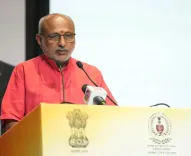How is India's Space Programme Reaching New Heights with Plans for Human Spaceflight in 2025?

Synopsis
Key Takeaways
- India launched a 4,400-kg communication satellite, enhancing its space capabilities.
- ISRO has established itself as a leader in affordable space technology.
- The Gaganyaan mission aims for human spaceflight by late 2025.
- India's low-cost missions have received global recognition.
- ISRO continues to inspire developing nations in space exploration.
New Delhi, Nov 16 (NationPress) India's ambitions in the field of space exploration are reaching remarkable heights, highlighted recently by the successful deployment of a 4,400-kg communication satellite—one of the heaviest ever launched by the nation, according to a report published on Sunday.
Since the debut of Aryabhata in 1975, India has been at the forefront of space technology, and this latest achievement further cements its reputation among the world's top spacefaring nations.
The Indian Space Research Organisation (ISRO) has developed a versatile array of satellites and showcased impressive launch capabilities through various vehicles, including the PSLV, GSLV, and LVM3, as noted in a report by timesofoman.com.
The forthcoming Small Satellite Launch Vehicle (SSLV) is expected to enhance India's influence in the burgeoning global small-satellite market.
ISRO has successfully launched a total of 354 foreign satellites from 34 different countries, achieving a world record by launching 104 satellites in a single mission in 2017.
India's reputation in space exploration soared after Chandrayaan-3's historic landing near the Moon's south pole in 2023—an accomplishment unmatched by any other nation.
This mission, which cost just $75 million—significantly less than many Hollywood space films—received accolades from global leaders and organizations such as NASA, the European Space Agency, and the Australian Space Agency.
ISRO's approach remains focused on low-cost, high-impact solutions.
The Mars Orbiter Mission (Mangalyaan), launched for a mere $74 million, made India the first Asian country to reach Martian orbit and the first globally to succeed on its maiden attempt.
Originally planned for six months, this mission provided scientific data for an impressive eight years.
India also made significant strides in solar science with the Aditya-L1 mission, which established a space observatory in a halo orbit around Lagrange Point 1, allowing for continuous observation of the Sun. This mission was developed at a cost of $46 million.
As per the report, India is gearing up for its most ambitious venture yet—the Gaganyaan mission, which aims to mark the nation’s inaugural human spaceflight, anticipated to take place in late 2025.
An unmanned test flight is scheduled for later this year.
This mission has garnered international attention, with French astronaut Thomas Pesquet calling it "extremely impressive" and expressing hope to fly alongside an Indian astronaut in the future.
With each milestone, India reaffirms its status as a leader in cost-effective, advanced space exploration, inspiring developing nations and transforming the global landscape of space travel.









